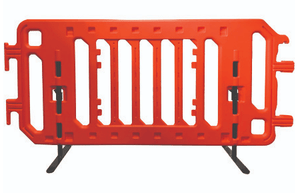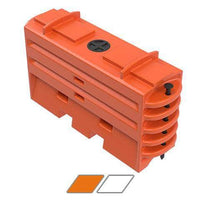What are the different types of traffic barricades?
Traffic barricades are designed to restrict vehicle interference or even pedestrian foot traffic from entering areas where workers may be at risk. For example road closures, construction zones, and maintenance areas can all be a danger without these highly visible barriers to help keep drivers aware. Traffic barricades are designed to meet or exceed specific standards set by the Federal Highway Administration and include traffic drums, plastic barricades, and metal barricades. Some of these can be customized with specific safety messaging or branding.
Traffic Barricades
Traffic Barricades For Road & Construction Safety
Construction is one of the highest-risk industries in the US and keeping workers safe is a large part of any construction site manager's job. The Occupational Safety and Health Association (OSHA) offers this Compliance Assistance Quick Start tool resource to help guide construction managers as they work to keep a compliant and safe worksite.
In OSHA's catalog of safety materials for construction sites, you'll recognize many of the products above. Even so, be sure to review OSHA's guidelines thoroughly, and we'll address some frequently asked questions below.
Here are some of the different types of traffic barricades you'll find in our collection:
-
Road Barriers: Road barriers refer to plastic jersey barriers which are portable and ballast-able for optimum stability. Sometimes these are also called "water-fillable barriers."
-
Folding Traffic Barricades: Folding barricades are easily stored folding barricades like A-frame barricades, Type 1 and Type II barricades, and Type III barricades.
-
Traffic Barrels: Traffic barrels are preferred for their easy portability, durability, and versatility with an extremely simple structure which requires no assembly.
- Traffic Signs: Traffic signs help fortify safety efforts and can be added to any safety barrier plan.
Traffic Barricade FAQs
-
What are the various types of Positive Protection Devices?
"Positive Protection Devices" typically refer to the barriers which can contain or redirect a moving vehicle and which meet specific crashworthiness criteria . Some common examples are concrete jersey barriers and ballast filled barriers, (explained below). You may have also seen these devices referred to as "jersey barriers".
These barricades are specifically designed to create a continuous barrier between workers and moving traffic while also minimizing the likelihood of vehicles being deflected into the oncoming lane of traffic in the event of a crash. This is achieved with the slight slope which allows tires to lift.
-
What are ballast filled barriers?
When a barrier is "ballast-able" it simply means it is hollow and can be filled with sand or water to add weight and sturdiness.
-
What does it mean when a steel barricade is "hot-dipped galvanized"?
When a steel barricade like this one is described as "hot-dipped galvanized", this means the structure is dipped in a molten-zinc bath. This treats the steel and makes it more weather-resistant and rust-resistant, even at the product joints. Read more about the galvanization process here.
-
How is a traffic barrel different from a standard traffic cone?
Traffic barrels (also called "traffic drums") are more cylindrical and create more of a barrier than traffic cones. This slightly sloping cylindrical shape also makes them very easy to stack and store.
-
What's the difference between speed bumps and "speed humps"?
Speed bumps create a steeper or higher protrusion which require slower traffic speeds than speed humps.


 Belt Barriers
Belt Barriers
 Barricades
Barricades
 Classic Stanchions and Ropes
Classic Stanchions and Ropes
 Wall Mounted Belt Barriers
Wall Mounted Belt Barriers
 Plastic Stanchion Posts and Chains
Plastic Stanchion Posts and Chains
 Signage
Signage
 Traffic Control
Traffic Control
 New Products
New Products

















